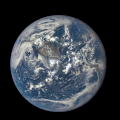Natural satellite
Natural satellite
A natural satellite or moon is an astronomical body that orbits a planet or a minor planet (or sometimes another small Solar System body). In the Solar System, there are six planetary satellite systems containing 205 known natural satellites. Earth's Moon is the fifth largest of the various moons and the most well-known, due to its close proximity to Earth.
Formation and characteristics
Natural satellites can form through several mechanisms. The most common theory suggests they form from accretion disks of material orbiting a planet, similar to how planets form around stars. Other theories propose that they may be captured objects from the surrounding space, remnants of a larger body that was shattered by impacts, or the result of a collision between a planet and another object, where the debris from such an event coalesces into a satellite.
Natural satellites vary greatly in size, composition, and origin. Their compositions can range from dense rocky bodies, like Earth's Moon, to icy bodies with subsurface oceans, such as Saturn's moon Enceladus, or even captured asteroids, like Mars' moons Phobos and Deimos. The characteristics of a moon can provide valuable insights into the history and evolution of its parent planet.
Orbital characteristics
The orbits of natural satellites are determined by the interplay of gravity between the moon, its parent planet, and the Sun. These orbits can be nearly circular or highly elliptical, and their orientation can lead to various phenomena, such as eclipses, transits, and occultations. Some moons have synchronous rotation, meaning they show the same face to their parent planet, as is the case with Earth's Moon.
Significance
Natural satellites have significant effects on their parent planets. They can affect planetary rotation, shape climate patterns, and influence geological activity. For example, the gravitational pull of Earth's Moon causes ocean tides. In some cases, the interaction between a planet and its moons can lead to tidal heating, driving geological activity, as seen on Jupiter's moon Io.
Exploration
The exploration of natural satellites has been a significant focus of space missions. These missions have ranged from flybys and orbiters to landers and rovers. The data collected from these missions have greatly enhanced our understanding of the Solar System, including the discovery of subsurface oceans on moons like Europa and Enceladus, which are considered potential habitats for extraterrestrial life.
List of notable natural satellites
- Earth's Moon – The only moon with a human presence to date.
- Ganymede – The largest moon in the Solar System, orbiting Jupiter.
- Titan – Saturn's largest moon, notable for its dense atmosphere and liquid hydrocarbon lakes.
- Io – A volcanically active moon of Jupiter.
- Europa – An icy moon of Jupiter, believed to harbor a subsurface ocean.
- Enceladus – A small moon of Saturn, known for its geysers ejecting water vapor and organic compounds.
See also
Transform your life with W8MD's budget GLP-1 injections from $125.
W8MD offers a medical weight loss program to lose weight in Philadelphia. Our physician-supervised medical weight loss provides:
- Most insurances accepted or discounted self-pay rates. We will obtain insurance prior authorizations if needed.
- Generic GLP1 weight loss injections from $125 for the starting dose.
- Also offer prescription weight loss medications including Phentermine, Qsymia, Diethylpropion, Contrave etc.
NYC weight loss doctor appointments
Start your NYC weight loss journey today at our NYC medical weight loss and Philadelphia medical weight loss clinics.
- Call 718-946-5500 to lose weight in NYC or for medical weight loss in Philadelphia 215-676-2334.
- Tags:NYC medical weight loss, Philadelphia lose weight Zepbound NYC, Budget GLP1 weight loss injections, Wegovy Philadelphia, Wegovy NYC, Philadelphia medical weight loss, Brookly weight loss and Wegovy NYC
|
WikiMD's Wellness Encyclopedia |
| Let Food Be Thy Medicine Medicine Thy Food - Hippocrates |
Medical Disclaimer: WikiMD is not a substitute for professional medical advice. The information on WikiMD is provided as an information resource only, may be incorrect, outdated or misleading, and is not to be used or relied on for any diagnostic or treatment purposes. Please consult your health care provider before making any healthcare decisions or for guidance about a specific medical condition. WikiMD expressly disclaims responsibility, and shall have no liability, for any damages, loss, injury, or liability whatsoever suffered as a result of your reliance on the information contained in this site. By visiting this site you agree to the foregoing terms and conditions, which may from time to time be changed or supplemented by WikiMD. If you do not agree to the foregoing terms and conditions, you should not enter or use this site. See full disclaimer.
Credits:Most images are courtesy of Wikimedia commons, and templates, categories Wikipedia, licensed under CC BY SA or similar.
Contributors: Prab R. Tumpati, MD






